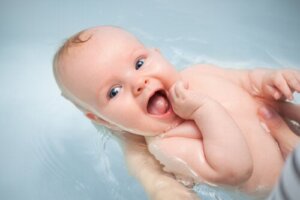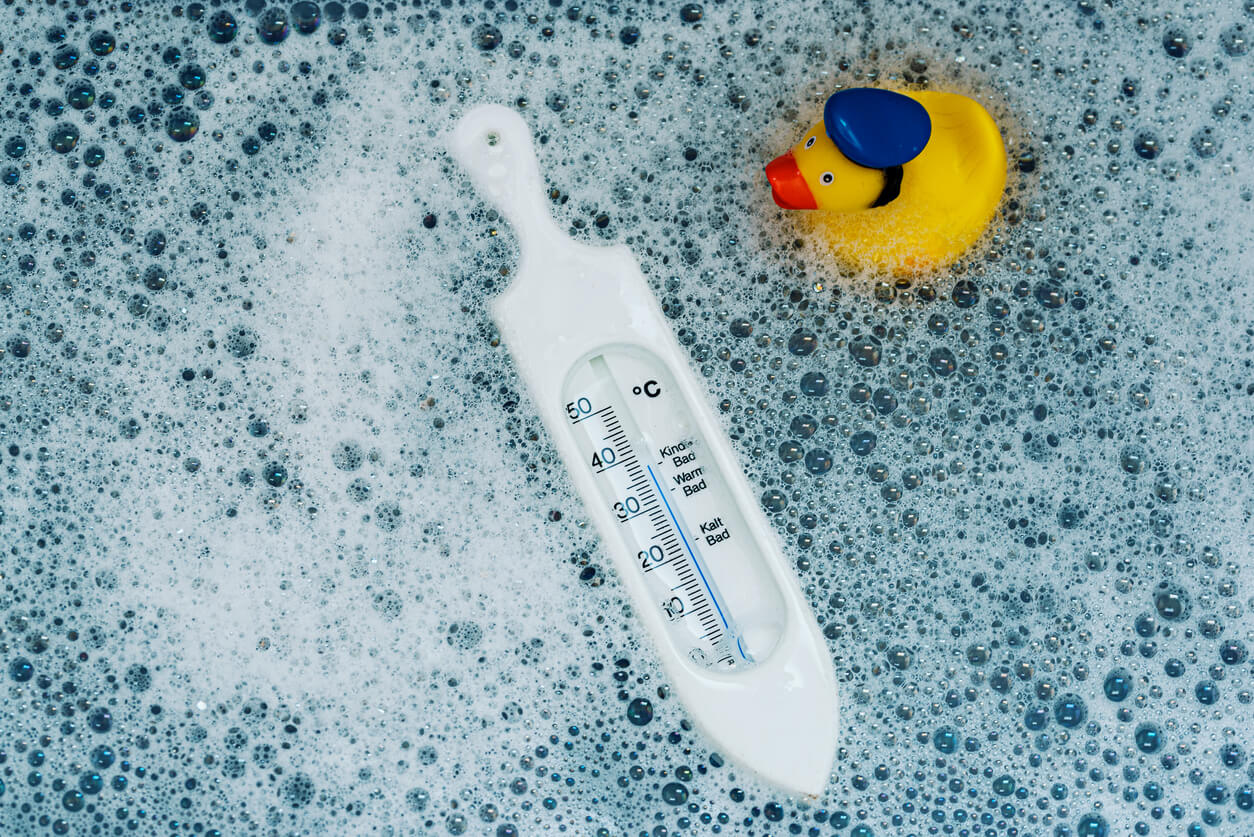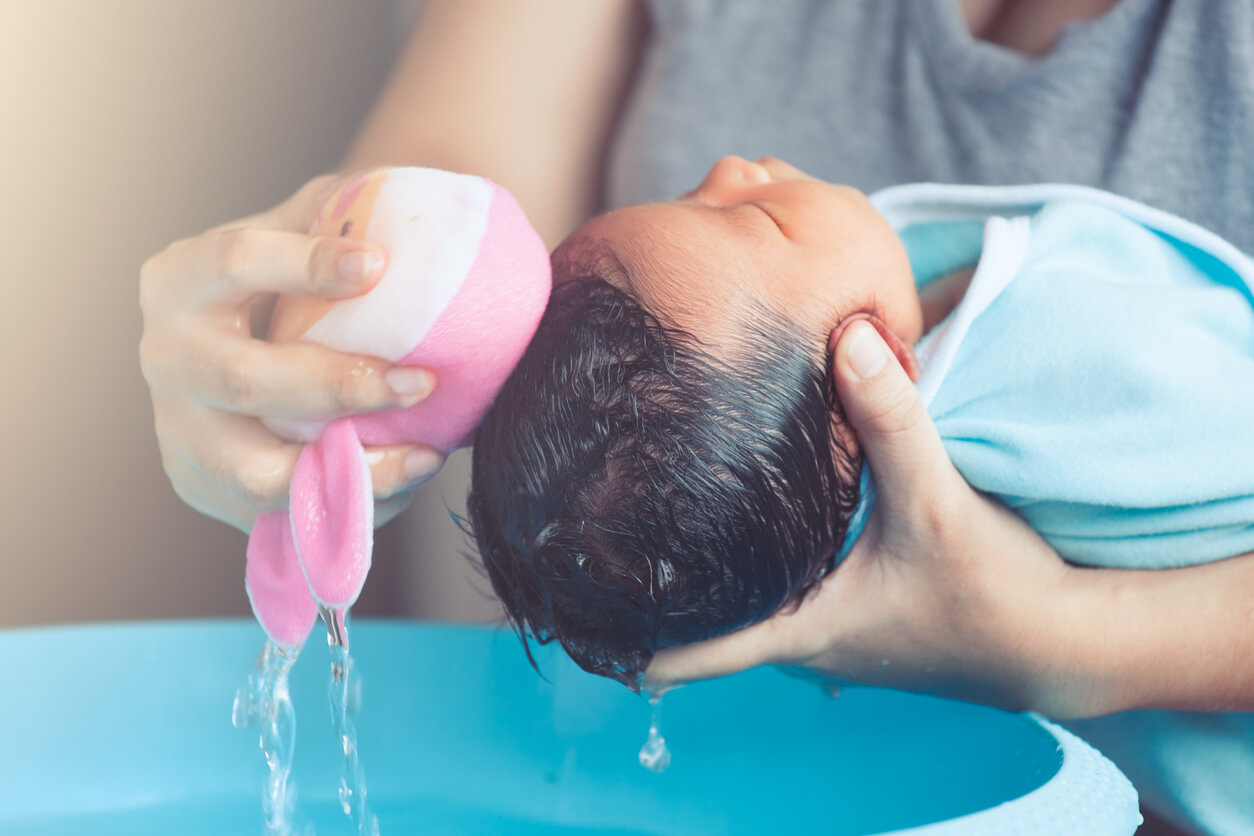10 Keys to Bathing Your Baby in Winter to Prevent Them from Getting Cold


Written and verified by the dermatologist Maria del Carmen Hernandez
Bathing your baby in winter and keeping them from getting cold is one of the greatest challenges for parents. There are many precautions to take in order to make the experience appropriate, safe, and pleasant for your little one.
Bathing at this age is much more than grooming, as it provides the baby with a series of sensory stimuli that are key to their physical and emotional development. Incorporating this habit into the routine helps them to relax and enjoy a pleasant moment together with their caregivers.
Here are some keys to optimizing this important daily experience. Don’t miss it!
Keys to bathing your baby in winter
Babies usually enjoy bathing and it even represents a moment of relaxation at the end of a busy day. This should be equally pleasurable in both summer and winter, but in the cold months, the challenge of creating a pleasant environment is somewhat greater. The fear of getting cold often interferes with the correct action of the parents and the whole scene ends up becoming stressful.
Pay attention to the following recommendations to maintain harmony inside the bathroom, no matter how cold it is outside.
1. Don’t bathe the child every day
Excessive bathing in infants can reduce the amount of bacteria that make up the natural microbiota of the skin. As a result, the skin becomes more susceptible to infection or superficial rashes.
Three baths per week during a baby’s first year is usually enough to ensure cleanliness without increasing the risk of damage.
2. Make sure that the temperature of the environment is adequate
The temperature inside the bathroom should be conditioned before bathing your baby in winter. Furthermore, windows and doors should be kept closed to limit drafts.
Turning on a heater a few minutes beforehand is a good option to warm up the environment.

3. Control the temperature of the water before submerging your baby
Another point to consider when bathing your baby in winter (or any time of year) is regulating the temperature of the water in the bathtub. You can control it with the back of your hand, with your elbow, or with a thermometer designed for this purpose.
The ideal water temperature should be around 95ºF so that there’s not too much contrast with the environment.
4. Choose the warmest times of the day
There are times during the day when the temperature of the environment is more favorable for bathing babies. It’s best to choose those moments and avoid exposing your baby to extreme weather, such as at dawn or dusk.
Read also: My Baby Has Reactive Skin
5. Offer short baths
Baths should be short and quick, as the prolonged permanence of the baby in the water isn’t beneficial for their skin. In addition, wet skin loses heat faster and this can make the baby uncomfortable.
6. Warm your hands
A large part of bathing babies includes body massages or skin-to-skin contact. Therefore, it’s important to warm your hands before you begin. You can rub your palms together or immerse your hands in warm water and, once they’re warm, take your baby and proceed with removing their clothes.
You should even take advantage of this moment to sanitize your hands before touching your baby’s bare skin.
7. Have the clothes that will be used later ready beforehand
It often happens that at the end of the bath, parents realize that they don’t have certain elements on hand, such as towels, blankets, or clothes.
To avoid this situation and keep your baby from getting cold, try to organize everything before bathing your little one, including toiletries, clothes, etc.
You may be interested in: Learn How to Properly Change a Diaper, Step by Step
8. Opt for soaps or gels that are suitable for infant skin
Extreme climates tend to dry out the skin or worsen this condition, leaving it more vulnerable to irritation or the development of dermatitis. Therefore, choosing soaps that moisturize the skin’s surface and don’t damage it is a good practice.
The most recommended infant cleansing products are those with a pH similar to that of the surface of the skin, such as creamy soaps (without detergents) or syndet soaps (detergent free).
9. Bathe your baby in stages
The head of little ones is a great source of heat and, as we’ve said before, wet skin loses this energy faster than when it’s dry.
That’s why a good strategy when bathing a baby, especially a newborn, is to do it in parts. First, immerse your baby in the tub and wash their trunk and limbs. Then wrap them in a towel and dry them off. When you notice that they’re calm and warm, proceed with washing their head, without taking too long. Finally, dry their hair with a dry towel, without pressing or rubbing vigorously on the fontanel.

10. Moisturize your baby’s skin after bathing in winter
Without a doubt, moisturizing after bathing your baby in winter is an essential habit. In fact, it’s the most common time to apply moisturizing creams or oils to babies and even to offer them some massages. These practices strengthen parenting bonds and relieve the infant’s tensions.
What should you take into account regarding your baby’s skin?
Your baby’s skin is more delicate and sensitive than that of an adult because it’s not fully developed. Therefore, you need to take certain precautions in terms of care during cleansing and in the choice of products to be used.
The essential thing is to keep the skin’s natural protective barrier intact, and this is achieved with good moisturizing and by avoiding direct contact with cold climates in the environment.
Bathing your baby in winter and keeping them from getting cold is one of the greatest challenges for parents. There are many precautions to take in order to make the experience appropriate, safe, and pleasant for your little one.
Bathing at this age is much more than grooming, as it provides the baby with a series of sensory stimuli that are key to their physical and emotional development. Incorporating this habit into the routine helps them to relax and enjoy a pleasant moment together with their caregivers.
Here are some keys to optimizing this important daily experience. Don’t miss it!
Keys to bathing your baby in winter
Babies usually enjoy bathing and it even represents a moment of relaxation at the end of a busy day. This should be equally pleasurable in both summer and winter, but in the cold months, the challenge of creating a pleasant environment is somewhat greater. The fear of getting cold often interferes with the correct action of the parents and the whole scene ends up becoming stressful.
Pay attention to the following recommendations to maintain harmony inside the bathroom, no matter how cold it is outside.
1. Don’t bathe the child every day
Excessive bathing in infants can reduce the amount of bacteria that make up the natural microbiota of the skin. As a result, the skin becomes more susceptible to infection or superficial rashes.
Three baths per week during a baby’s first year is usually enough to ensure cleanliness without increasing the risk of damage.
2. Make sure that the temperature of the environment is adequate
The temperature inside the bathroom should be conditioned before bathing your baby in winter. Furthermore, windows and doors should be kept closed to limit drafts.
Turning on a heater a few minutes beforehand is a good option to warm up the environment.

3. Control the temperature of the water before submerging your baby
Another point to consider when bathing your baby in winter (or any time of year) is regulating the temperature of the water in the bathtub. You can control it with the back of your hand, with your elbow, or with a thermometer designed for this purpose.
The ideal water temperature should be around 95ºF so that there’s not too much contrast with the environment.
4. Choose the warmest times of the day
There are times during the day when the temperature of the environment is more favorable for bathing babies. It’s best to choose those moments and avoid exposing your baby to extreme weather, such as at dawn or dusk.
Read also: My Baby Has Reactive Skin
5. Offer short baths
Baths should be short and quick, as the prolonged permanence of the baby in the water isn’t beneficial for their skin. In addition, wet skin loses heat faster and this can make the baby uncomfortable.
6. Warm your hands
A large part of bathing babies includes body massages or skin-to-skin contact. Therefore, it’s important to warm your hands before you begin. You can rub your palms together or immerse your hands in warm water and, once they’re warm, take your baby and proceed with removing their clothes.
You should even take advantage of this moment to sanitize your hands before touching your baby’s bare skin.
7. Have the clothes that will be used later ready beforehand
It often happens that at the end of the bath, parents realize that they don’t have certain elements on hand, such as towels, blankets, or clothes.
To avoid this situation and keep your baby from getting cold, try to organize everything before bathing your little one, including toiletries, clothes, etc.
You may be interested in: Learn How to Properly Change a Diaper, Step by Step
8. Opt for soaps or gels that are suitable for infant skin
Extreme climates tend to dry out the skin or worsen this condition, leaving it more vulnerable to irritation or the development of dermatitis. Therefore, choosing soaps that moisturize the skin’s surface and don’t damage it is a good practice.
The most recommended infant cleansing products are those with a pH similar to that of the surface of the skin, such as creamy soaps (without detergents) or syndet soaps (detergent free).
9. Bathe your baby in stages
The head of little ones is a great source of heat and, as we’ve said before, wet skin loses this energy faster than when it’s dry.
That’s why a good strategy when bathing a baby, especially a newborn, is to do it in parts. First, immerse your baby in the tub and wash their trunk and limbs. Then wrap them in a towel and dry them off. When you notice that they’re calm and warm, proceed with washing their head, without taking too long. Finally, dry their hair with a dry towel, without pressing or rubbing vigorously on the fontanel.

10. Moisturize your baby’s skin after bathing in winter
Without a doubt, moisturizing after bathing your baby in winter is an essential habit. In fact, it’s the most common time to apply moisturizing creams or oils to babies and even to offer them some massages. These practices strengthen parenting bonds and relieve the infant’s tensions.
What should you take into account regarding your baby’s skin?
Your baby’s skin is more delicate and sensitive than that of an adult because it’s not fully developed. Therefore, you need to take certain precautions in terms of care during cleansing and in the choice of products to be used.
The essential thing is to keep the skin’s natural protective barrier intact, and this is achieved with good moisturizing and by avoiding direct contact with cold climates in the environment.
All cited sources were thoroughly reviewed by our team to ensure their quality, reliability, currency, and validity. The bibliography of this article was considered reliable and of academic or scientific accuracy.
- Johnson E, Hunt R. Infant skin care: updates and recommendations. Curr Opin Pediatr. 2019 Aug;31(4):476-481. doi: 10.1097/MOP.0000000000000791. PMID: 31188166.
- Mendes BR, Shimabukuro DM, Uber M, Abagge KT. Critical assessment of the pH of children’s soap. J Pediatr (Rio J). 2016 May-Jun;92(3):290-5. doi: 10.1016/j.jped.2015.08.009. Epub 2016 Feb 1. PMID: 26844391.
- Telofski LS, Morello AP 3rd, Mack Correa MC, Stamatas GN. The infant skin barrier: can we preserve, protect, and enhance the barrier? Dermatol Res Pract. 2012;2012:198789. doi: 10.1155/2012/198789. Epub 2012 Sep 4. PMID: 22988452; PMCID: PMC3439947.
This text is provided for informational purposes only and does not replace consultation with a professional. If in doubt, consult your specialist.








